To be successful at email marketing, you need to grow your list of email subscribers. To grow your list of subscribers, you need a great email signup form. The growth of your email list depends on how you design that little box.
In the next few minutes, you’ll learn how to get more email subscribers for your blog by improving your email subscriber form.
It’s actually very simple. There are three main factors that all of the best newsletter signup forms have in common. Coincidentally, they all start with ‘p’ so we’ll call these…
The 3 P’s of Email Signup Forms
1. Prominence
The signup form is visually prominent on the page. You can’t miss it. That probably means it’s big, but it’s more than that. Here are a few ways to make your email signup box more visible.
- Color contrast
The color contrasts with the colors around it, especially the subscribe button. See a few examples below. - “Sticky” elements
It’s a “sticky” element, so it’s always visible no matter how far down the visitor scrolls. Notice the sticky footer on this page. - Multiple locations
It’s all over the place. At the top of the blog main page. At the bottom on every post. On the about page, in the footer, etc. We get a lot of subscribers from the signup box on our contact form thank you page. - The Popup
The email signup popup window (aka lightbox, aka modal window) is everywhere. Of course, 0% of visitors like them. But 100% of marketers report that they are effective at list growth. It’s a judgement call. We’ve resisted them for years, but we’re starting to experiment. You can find more tips and examples here.
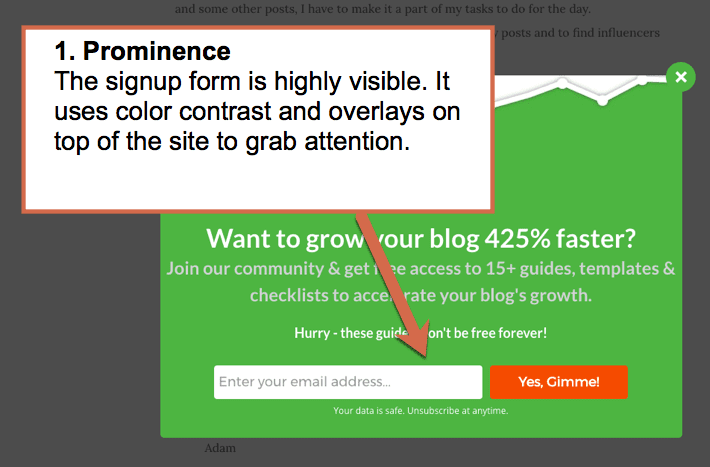
Now that everyone is seeing your signup box, let’s look at what we have inside…
2. Promise
Make a promise to the visitor. Tell them what they’ll get if they subscribe. Sadly, most signup forms don’t do this. The best newsletter signup forms tell the visitor two things:
- The topic of the email newsletter
- How frequently they’ll get your emails
If you don’t tell them these things, why would they subscribe? You need to answer the question, “what’s in it for me?” and tell them the benefits of being on the list. Keep reading to see good and bad examples of this.
Pro Tip: Publish your content marketing mission statement at the top of your blog and every visitor can see what you publish and why they should sign up. The Swift Passport Visa & Passport Blog is a great example.
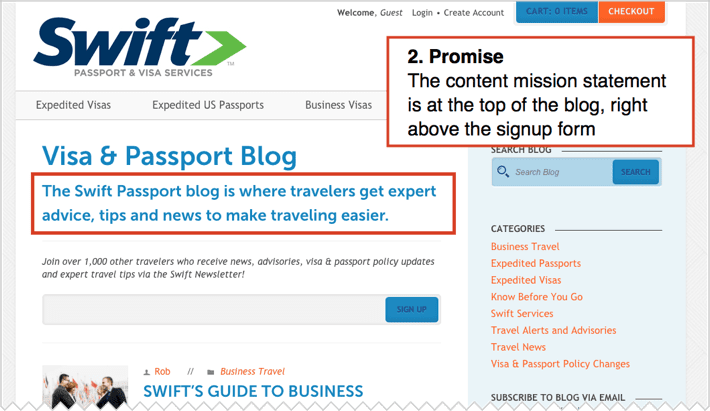
3. Proof
The third P is proof, as in social proof. To get visitors to act, you need to add evidence that the blog is worth reading and the newsletter is worth subscribing to.
There are two kinds of proof you can use:
- Number of subscribers (quantitative)
You should have at least 1000 subscribers before this works well, so this is best for established blogs. - A testimonial from a fan (qualitative)
A quote from a fan who loves you is effective because it’s personal. If it comes from someone well known to your readers, it’s more than a testimonial – it’s an endorsement.
You’ll see subscriber counts and qualitative proof in the examples below, but here’s a nice example of an endorsement. Rather than show numbers, Brian Dean of Backlinko adds a short quote.
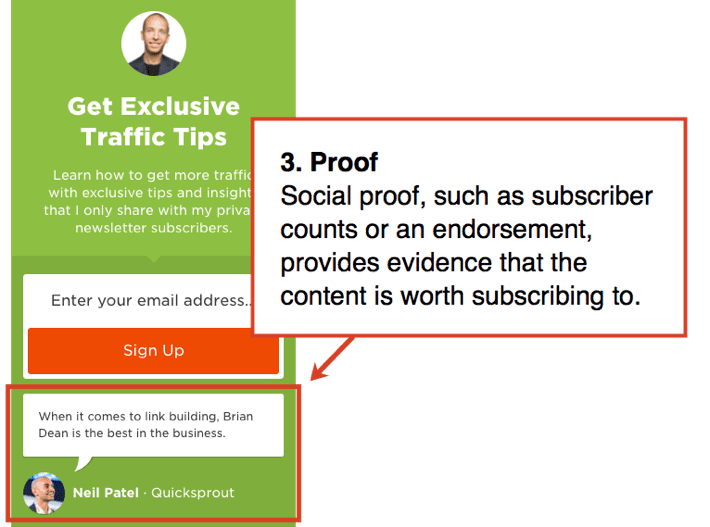
Bonus P’s!
Beyond those three, most important basics, there are other ways to make your signup boxes even more effective. And yes, they all start with P.
Presents
Offer a present or a gift for the subscriber. This is often called a “content upgrade” or “lead magnet.” It’s really an ethical bribe. You’re trading higher-value content for their email address. You’ll find some great examples here: 12 Lead Magnet Ideas and Examples.
You can see this the first example above: “Grab 7 Keys to Marketing Success! Get it free.” This incentive to give an email address will increase the percentage of visitors who subscribe. Technically, they’re not subscribing to the newsletter, but visitors know that you’ll be sending them email.
Our friend and conversion expert Justin Rondeau has tested everything and found the presents that work the best – and the ones that don’t work so well.
- Good: toolkits, reports, case studies, free downloads, assessments, quizzes, cheatsheets
- Bad: ebooks, long whitepapers, webinars, generic info, contact us
 |
“I can see that people will look at webinars and say “BS – I get tons of leads with webinars!” The reason webinars aren’t great for colder lead generation (or generating leads from an audience that doesn’t really know you) is because there is a higher perceived COST. Time is expensive and getting into someone’s calendar changes the relationship in a similar way as a monetary transaction (often referred to as the Tripwire offer at DigitalMarketer). Essentially webinars are asking too much at that point in the customer journey. You generally start with asking someone to coffee (gifts of value first content) before asking them to dinner (webinar or sale).” – Justin Rondeau, Director of Optimization, Digitalmarketer.com |
Some gifts have higher perceived value than others!
Personality
Images of faces make the site more human and more personal. They also help increase prominence because they pull in the visitor’s attention. People tend to gaze at faces more than other imagery from the time we are infants.
Using a face also gives you a chance to get the visitor to look in a certain direction. It’s the “you look where they look” phenomenon. If the face in the picture is looking in a direction, visitors tend to also look in that direction.
Chris Ducker does this beautifully in his signup form, directing your eyes to the headline.
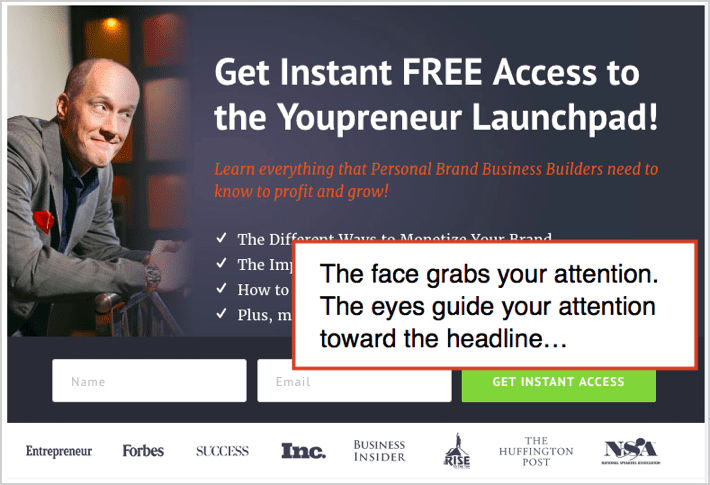
Also, notice his use of presents and proof. This signup box is a masterpiece!
Privacy
The final P is for privacy. If trust levels are low with your audience, you can add a note that reassures them that you won’t share or sell their information with anyone else.

Warning: Privacy reminders can backfire!
Some studies have found that even mentioning a negative word like “spam” can reduces signups because it can trigger a concern that they didn’t have. Michael Aagaard of Unbounce ran a test that showed the text “100% spam free” reduced conversion rates by 18%.
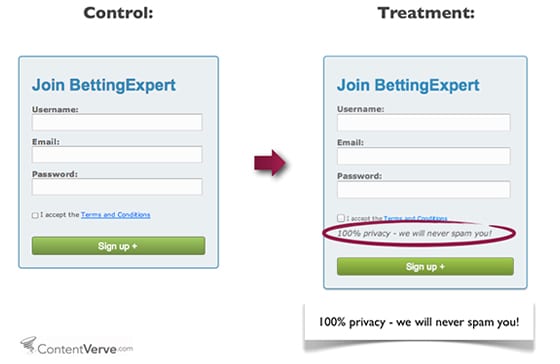
He recommends avoiding using the word “spam” anywhere near newsletter signup forms.
7 Email Subscription Form Examples
We’ve shown a few above. Here are seven more examples of email signup forms, good and bad. Let’s start with Orbit, since we have access to Analytics and can show the impact of different designs.
1. Orbit Media: 4,863% increase in subscribers
For years, we had a link at the top of the blog that let visitors click to get to a page with a signup box. It looked like this. It was wordy, yet vague. And the actual signup was on a separate page.
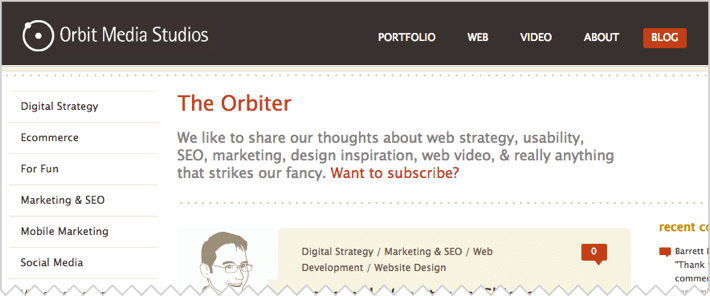
Then one day, we made a change. We let people subscribe without leaving the page. We also trimmed the text and added the three P’s.
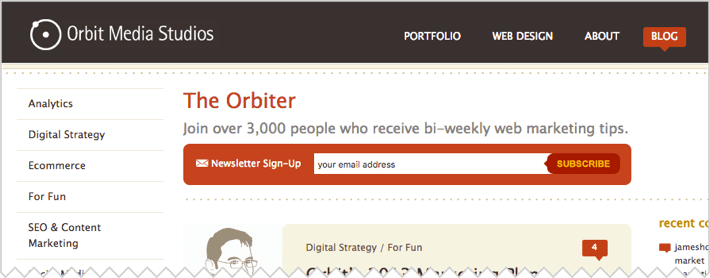
And here’s what happened to the conversion rates. Look at the Google Analytics for signups and conversion rates during this period.
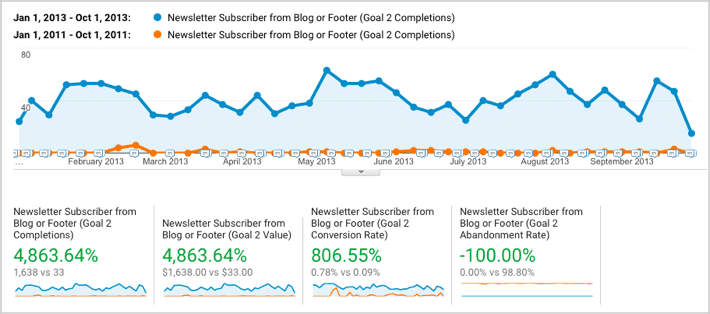
Yes, you are reading that right. That’s a 806% increase in the conversion rate leading to a 4,863% increase in newsletter subscriptions. Aside from the change to the form, the only change we made in our marketing was an increase in publishing frequency during two months of 2013.
Also, notice how the abandonment rate dropped to zero. That’s because the form wasn’t on a separate page. There’s nothing to abandon. Readers sign up or they don’t!
Since then, we’ve experimented with other designs with mostly consistent results. This design increased the prominence by making the box a big red square.
It also emphasized the name of the blog, “The Orbiter.” But does naming your newsletter affect your subscription rates?
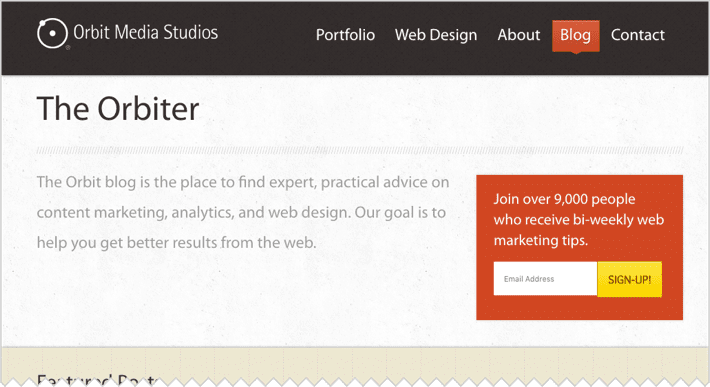
No, not according to our data. In a more recent redesign, we removed the name of the blog and no one noticed. The subscriber rates didn’t change. No one cares what you name your blog.
Here are six more examples from popular marketing websites. Let’s count the P’s or conversion optimization tactics for each:
2. Marketing Profs: Obvious, spacious, credible
The Marketing Profs form does four specific things to maximize subscriptions.
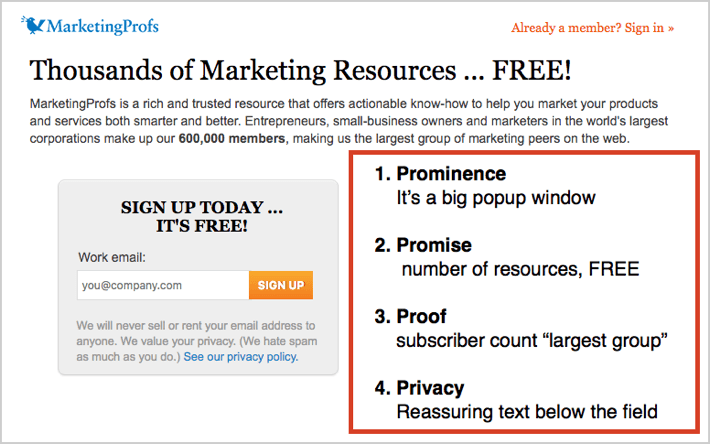
- It’s prominent. This is a large popup window on the first page. There are also other opportunities to sign up from other pages on the site.
- The promise is the content “Thousands of Marketing Resources” and “actionable know-how to help you market your products and services both smarter and better.” It also tells you who should subscribe: “Entrepreneurs, small-business owners and marketers.”
- The proof is in the subscriber count, which is bolded text and the line “largest group of marketing peers on the web” Sounds good!
- Even privacy is addressed with a few lines of text and a link to the privacy policy. I have to wonder if removing the word spam and that little exit link would improve results.
3. Unbounce: Relevant, valuable, in the flow
Our friends at Unbounce have been experimenting with “in-line calls to action” which puts an offer right into the body text of an article. It’s less of an interruption that a popup window, but still very prominent.
The offer is great for the audience. It’s a report that lets you compare your conversion rate to others. The subscription is secondary, and listed below the form field: “By entering your email you’ll receive other resources to help you improve your conversion rates.”
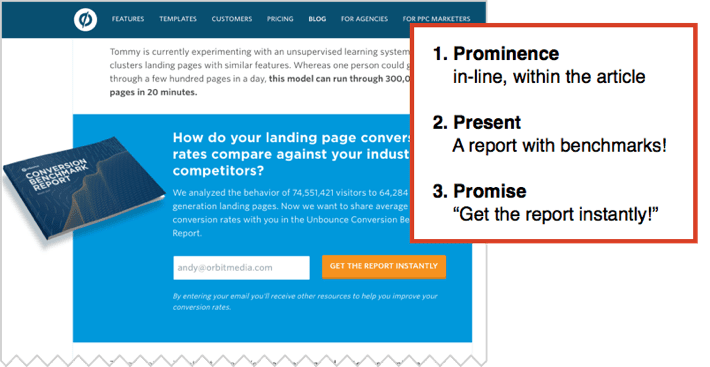
4. Vertical Measures: Sticky header with a simple promise
When you land on the Vertical Measures blog, there is a large header with a simple call to action.
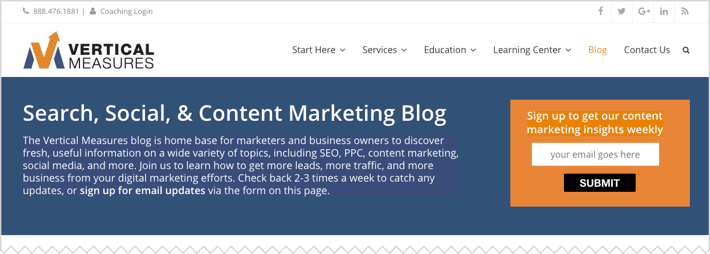
The headline tells you the topics: “Social, Search, & Content Marketing Blog” which is more of a promise than a branded name. The paragraph below is probably too long for most visitors to read, but the box on the right tells you the frequency: “Sign up to get our content marketing insights weekly”
The box doesn’t include any social proof, but it is big and prominent, with light text on a dark background, unlike everything else on the page.

It’s also a sticky element (like the footer of this blog). When you scroll down, it shrinks into a smaller version and no matter how far down you scroll, the signup box is still there at the top.
5. Name withheld: The greedy form
Let’s take a long hard look at the worst email signup form I’ve even seen.
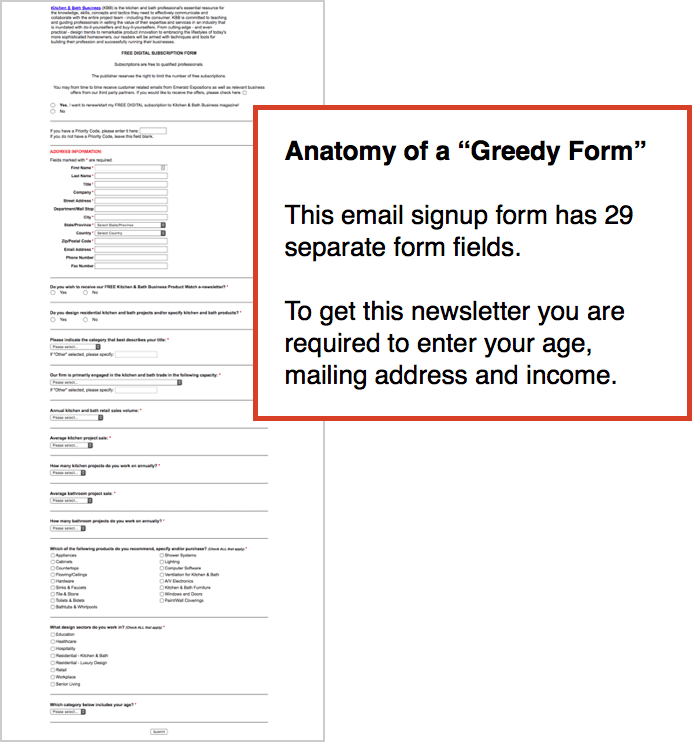
A “greedy form” is a form that requires the visitor to enter more information than they believe is necessary. It asks for a lot and offers very little.
This form is definitely greedy. To get this newsletter, you have to complete 29 fields. 27 of them are required, including age, income and mailing address. It’s basically a survey.
This form is 2500 pixels tall, but that doesn’t make it prominent. It’s on a separate page, accessed from a small gray link buried in the main navigation.
True story: I actually met this company. They came in to meet with us for some content strategy advice. I asked them why they require so much information from subscribers. They explained they were planning to do analysis on the list someday. I had to ask, “How is the data collection coming along?” They confessed that no one had subscribed.
6. Name withheld: The last-minute whisper
Our next example is the most common. It’s the website footers signup and we’ve built them into dozens of websites. We show it here with examples of good and bad.
If the footer signup form doesn’t include any of the P’s. If it’s nothing more than a lonely box with the words, “email signup” and a submit button, then it’s not likely to grow your list. In fact, it would be strange if anyone entered their email address!

7. Acquirent: A compelling footer form
A better example is the Acquirent website. It has visual prominence (the green color), promise (sales and marketing tips) and proof (13,000 subscribers).
One final tip about footer signup forms:
They shouldn’t be only place for visitors to subscribe. This should be one of several places. This is just the final call to action, visible on every page, similar to social media icons.
We hope you enjoyed this analysis of email signup forms, and the examples, good and bad. For more tips on how to keep your new fans engaged once they sign up, read our welcome series email tips.
Getting some ideas? Leave us a comment with an example or idea of your own!





